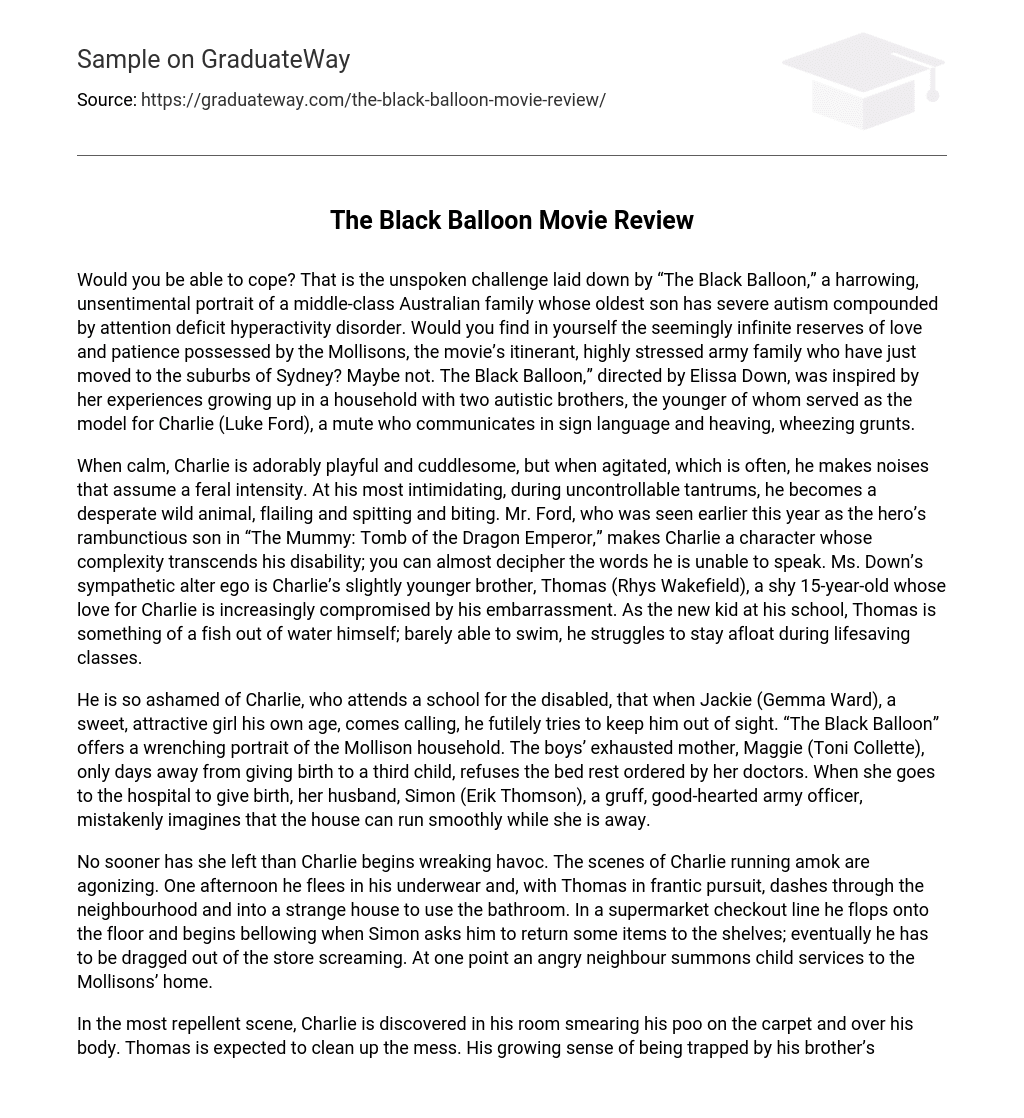The unspoken challenge posed by “The Black Balloon” is to see if one could handle the same situation as the Mollisons, a middle-class Australian family whose eldest son has severe autism and attention deficit hyperactivity disorder. The film, directed by Elissa Down, draws from Down’s own upbringing with two autistic brothers, one of whom inspired the character of Charlie. Charlie, portrayed by Luke Ford, is mute and communicates through sign language and grunting. “The Black Balloon” offers a harrowing and unsentimental portrayal of this family’s experience, emphasizing the need for love and patience. Despite their constant stress as an army family recently moved to Sydney’s suburbs, the Mollisons display seemingly infinite reserves of these qualities.
When calm, Charlie is adorably playful and cuddlesome, but when agitated, which is often, he makes noises that assume a feral intensity. During uncontrollable tantrums, he becomes a desperate wild animal, flailing and spitting and biting. Mr. Ford, who was seen earlier this year as the hero’s rambunctious son in “The Mummy: Tomb of the Dragon Emperor,” makes Charlie a character whose complexity transcends his disability; you can almost decipher the words he is unable to speak. Ms. Down’s sympathetic alter ego is Charlie’s slightly younger brother, Thomas (Rhys Wakefield), a shy 15-year-old whose love for Charlie is increasingly compromised by his embarrassment. As the new kid at his school, Thomas is something of a fish out of water himself; barely able to swim, he struggles to stay afloat during lifesaving classes.
He is incredibly embarrassed by Charlie, who goes to a school for disabled individuals, to the point that when Jackie (Gemma Ward), a kind and attractive girl his age, comes to visit, he futilely tries to keep Charlie out of sight. “The Black Balloon” presents a heartrending depiction of the Mollison household. The boys’ weary mother, Maggie (Toni Collette), who is just days away from giving birth to their third child, disregards the prescribed bed rest from her doctors. When she goes to the hospital to give birth, her husband, Simon (Erik Thomson), a gruff but good-natured army officer, mistakenly assumes that the household can function smoothly in her absence.
No sooner does she leave than Charlie starts causing chaos. The sight of Charlie rampaging is painful. One day, he sprints through the neighborhood in his underwear, with Thomas desperately chasing after him, and barges into a unfamiliar house to use the restroom. In a supermarket queue, he throws himself onto the ground and starts shouting when Simon requests that he put back some items on the shelves; eventually, he has to be pulled out of the store while screaming. At one moment, an enraged neighbor calls child services to the Mollisons’ residence.
In the most shocking scene, Charlie is found in his room smearing his feces on the carpet and his body. Thomas is tasked with cleaning up the mess. The increasing feeling of being trapped by his brother’s disability is depicted when he anxiously listens to Charlie’s noises and the cries of the newborn through his bedroom door. The blossoming romantic feelings between Thomas and Jackie bring a welcome touch of tenderness to “The Black Balloon.” Mr. Wakefield and Ms. Ward portray the innocence of timid, sensitive young individuals for whom a tentative shared kiss is a significant event. However, it is Ms. Collette’s Maggie who drives the film. This extraordinary Australian actress, devoid of any self-importance, completely immerses herself in complex characters she portrays, with Maggie being one of her strongest. Through her powerful gestures and intense glances, Ms. Collette presents Maggie as an unwavering woman of determination and inner strength who manages to keep chaos at bay.





